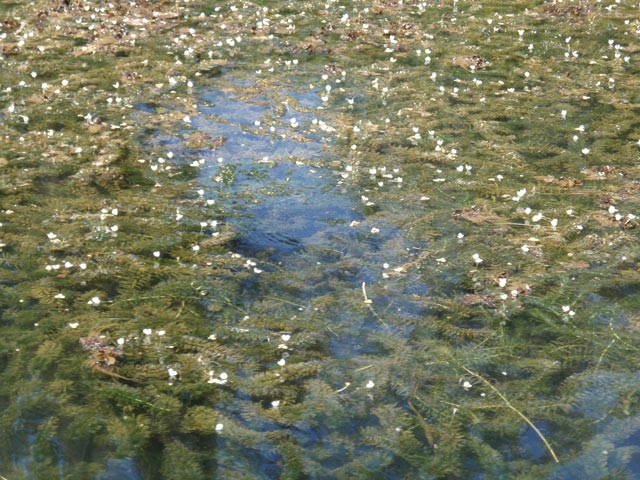Leafy elodea
Leafy elodea (Egeria densa) is a submerged aquatic perennial weed that grows in shallow, slow-moving or stationary water bodies which are rich in nutrients. It is native to parts of South America and occurs mainly in southern New South Wales and south-east Queensland.
This sub-project will import the promising candidate biocontrol agent for leafy elodea, the leaf-mining fly Hydrellia egeriae, from South Africa where it has been released, into a containment facility in Australia. Once a culture of the fly is established, host-specificity testing will be performed with five Australian native species closely related to the target weed. Leafy elodea belongs to the family Hydrocharitaceae, which contains genera that are grouped into two clades. Leafy elodea is grouped into Clade B, which has a few species/genera native to Australia (e.g. Blyxa, Ottelia). Clade A also comprises species/genera native to Australia (e.g. Hydrilla, Vallisneria). Five native species across both clades which are accessible and have a geographical distribution that overlaps that of the target weed will be selected for testing using replicated lifecycle completion trials under no-choice condition.
If a non-target species supports development of the fly in more than two replicates across the no-choice trials, then choice trials with that species will be performed. If the fly develops on a species in choice trials, then continuation trials will be set-up with that species to fully assess risks. If one or more of the native species are shown to support a population of the fly over several generations in the continuation trials, the culture will be terminated, and this candidate agent will not be pursued further. If, however, the trials demonstrate that the fly does not pose a threat to the tested native species, a proposal will be developed for testing additional species relevant to the Australian context to gather all necessary information to apply for its release in Australia.
Kumaran Nagalingam of CSIRO is leading this sub-project.

An infestation of leafy elodea (Egeria densa) (Photo: Rebecca Coventry, NSW WeedWise).
Background
Why is the weed a problem?
Leafy elodea invades slow-moving waterbodies to depths of around seven metres, where it restricts water flow, increases siltation, reduces aquatic biodiversity, and interferes with recreation activities. It spreads via stem pieces broken from the main plant and seed production has not been recorded in Australia where only male plants occur.
How is the weed currently managed?
Mechanical harvesting of leafy elodea is used to reduce the bulk of the weed, but plant eventually regrows. Increasing and varying water flows and reducing nutrient inputs into the invaded waterbodies are required to achieve long-term management of leafy elodea. Herbicidal treatment is possible, but since the weed is in waterways only limited options are available.
For more detail see https://weeds.dpi.nsw.gov.au/Weeds/Leafyelodea
Previous research
The leaf-mining fly Hydrellia egeriae, that originates in South America, was found to only complete development on another Egeria sp. and on two Elodea species in host-specificity testing performed in Argentina and the USA. It has, however, been deemed unsuitable for continued research in the USA because Elodea canadensis, on which the fly can complete development, is a native species in North America. It is noteworthy that Egeria and its closely related genus Elodea do not contain any native Australian species.
The leaf-mining fly was first released in 2018 in South Africa. Despite experiencing some parasitism, the fly is confirmed established at all three sites where it has been released (J. Coetzee, Rhodes University, pers. comm.). Damage on the weed is notable at a site where multiple releases have been made. The fly has been observed to inflict severe damage on the weed during mass-rearing.
Trust-funded sub-project
The key activities of the sub-project are to:
- Import the leaf-mining fly fly into an Australian quarantine facility and establish/maintain a culture.
- Conduct replicated no-choice trials with the fly with each of five non-target species closely related to the target weed. Depending on results perform subsequent choice/continuation trials.


